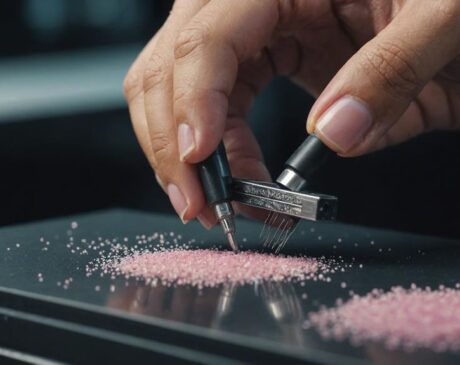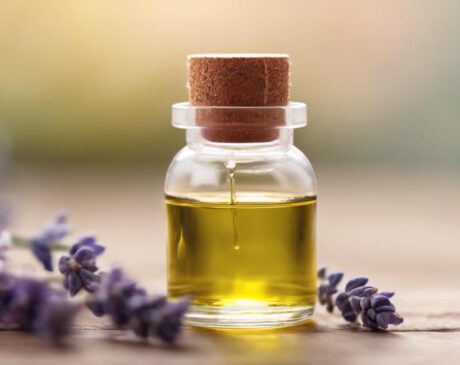What Is Bad for Your Nails?

Exposure to harsh chemicals in nail products like formaldehyde and toluene can lead to dryness, brittleness, and yellowing of your nails. It's essential to avoid these harmful ingredients. Additionally, not keeping your nails adequately moisturized can weaken them. Hydration is crucial for nail resilience, so using nail and cuticle oil is recommended. Poor nutrition, like lacking essential vitamins and protein, can also impact nail health. Habits such as nail biting and picking can weaken nails and make them prone to breakage. Excessive use of acrylics can weaken the natural nail bed. Maintaining nail health requires proper care techniques.
Key Takeaways
- Harsh chemicals in nail products like formaldehyde, toluene, and phthalates damage nails.
- Lack of moisture leads to dry, brittle nails; use hydrating nail oils and gloves.
- Poor nutrition impacts nail health; consume vitamins and proteins for strong nails.
- Nail biting weakens nails, increases infection risk, and affects appearance.
- Excessive acrylic use weakens natural nails, causes infections, and damages nail beds.
Harsh Chemicals in Nail Products
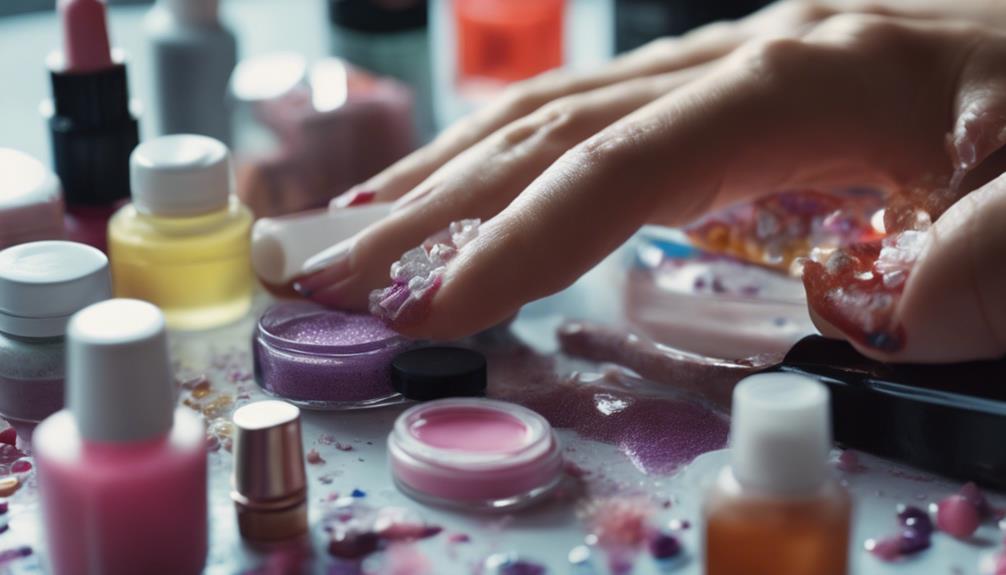
In the realm of nail care, the presence of harsh chemicals in nail products poses a significant concern for consumers and professionals alike. These chemicals, often found in nail polishes, removers, and strengtheners, can have detrimental effects on the health and appearance of nails. Formaldehyde, toluene, and dibutyl phthalate are common culprits known to cause dryness, brittleness, and yellowing of nails. For individuals seeking to maintain healthy and beautiful nails, avoiding products containing these harmful chemicals is paramount.
Nail technicians, in particular, need to be vigilant about the products they use on clients to uphold the highest standards of care and safety. Educating clients about the potential risks associated with harsh chemicals in nail products is essential for building trust and ensuring their well-being. By offering healthier alternatives and promoting natural nail care practices, professionals can help clients achieve optimal nail health without compromising on aesthetics.
Lack of Moisture and Hydration
Insufficient moisture and hydration are common factors that contribute to nail health concerns, affecting both the appearance and strength of nails. Nails, like skin, require proper hydration to maintain their health and resilience. When nails lack moisture, they become brittle, dry, and prone to breakage. This can lead to issues such as split nails, ridges, and peeling.
To combat the negative effects of dehydration on nails, it is essential to incorporate practices that promote moisture retention. Regularly applying a moisturizing nail and cuticle oil can help restore hydration and improve the flexibility of the nails. Additionally, using gloves while performing household chores or working with water can prevent nails from becoming excessively dry.
Maintaining adequate hydration levels by drinking enough water throughout the day also plays a crucial role in nail health. Dehydration can manifest in brittle and weak nails, emphasizing the importance of internal hydration for overall nail strength. By prioritizing moisture and hydration, individuals can safeguard their nails against common issues associated with dryness.
Poor Nutritional Choices
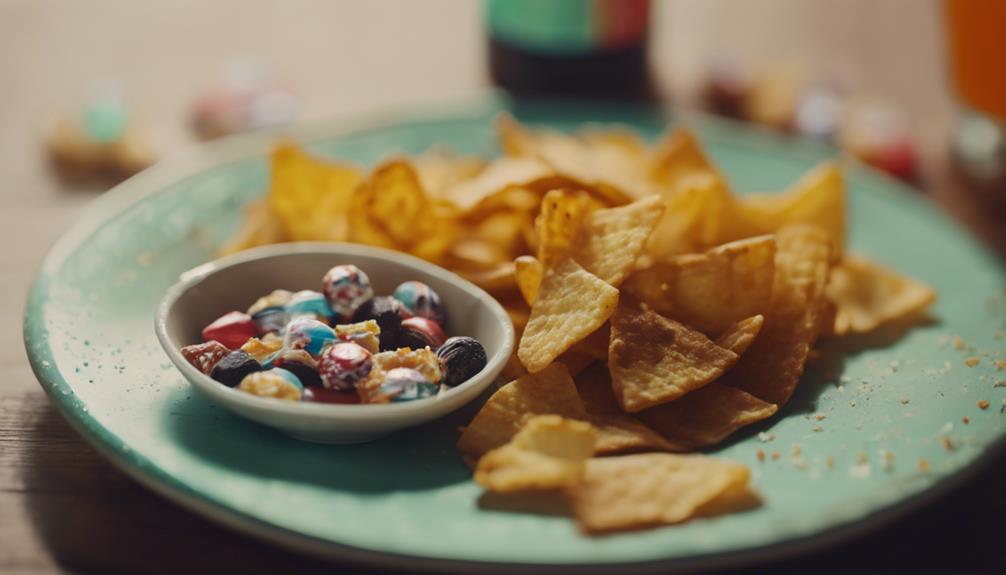
Insufficient intake of essential vitamins and low protein consumption can significantly impact nail health. Vitamins like biotin, vitamin E, and vitamin C play a crucial role in maintaining strong and healthy nails. Neglecting these nutrients in your diet can lead to brittle nails, slow growth, and overall poor nail condition.
Lack of Vitamins
Due to inadequate intake of essential vitamins, nail health can be compromised, leading to various concerns. Nutritional choices play a significant role in maintaining strong and healthy nails. When essential vitamins are lacking in the diet, it can manifest in the form of brittle and discolored nails. Some key vitamins for nail health include:
- Vitamin A: Supports nail growth and strength.
- Vitamin B: Helps prevent nail brittleness.
- Vitamin C: Promotes collagen production for healthy nail growth.
- Vitamin E: Improves blood circulation to the nail bed for better nourishment.
Ensuring a balanced diet rich in these vitamins is crucial for maintaining optimal nail health and preventing related issues.
Low Protein Intake
A significant factor impacting nail health is the inadequate intake of protein, which can result from poor nutritional choices. Protein plays a crucial role in building strong nails, as it contains amino acids essential for their structure. When protein intake is low, nails may become weak, brittle, or grow slowly, affecting their overall health and appearance. To address this issue, individuals should include protein-rich foods like lean meats, poultry, fish, eggs, dairy products, legumes, nuts, and seeds in their diets. Consulting with a healthcare provider or a nutritionist can help create a balanced meal plan tailored to meet the body's protein needs and promote healthy nail growth. Prioritizing protein intake is vital for maintaining strong and healthy nails.
Nail Biting and Picking
Amidst common nail health concerns, nail biting and picking can be detrimental habits that affect both the appearance and overall health of nails. These habits can lead to a variety of issues that compromise the strength and beauty of your nails. Here are some key points to consider:
- Damage to Nail Bed: Nail biting and picking can cause damage to the nail bed, leading to pain and discomfort.
- Increased Risk of Infections: By biting or picking at your nails, you increase the likelihood of introducing harmful bacteria into your nail beds.
- Weakening of Nails: Continuously subjecting your nails to biting or picking can weaken them, making them more prone to breakage.
- Impact on Nail Appearance: These habits can result in irregular nail growth and shape, affecting the overall appearance of your nails.
It is essential to be mindful of these habits and take steps to address them to maintain healthy and beautiful nails.
Excessive Use of Acrylics
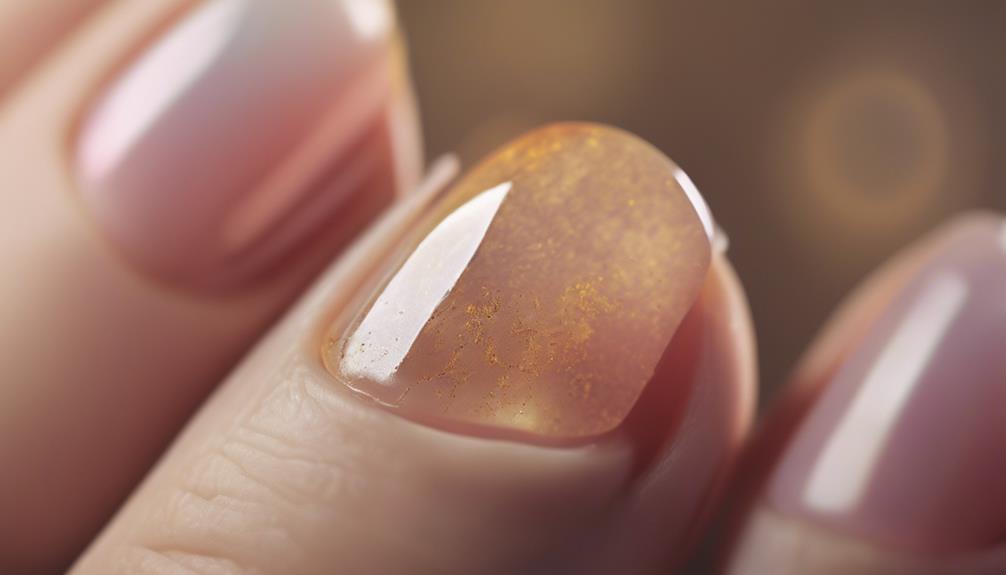
Excessive use of acrylics in nail care can pose various risks and concerns for nail health. Acrylic nails are popular for their durability and aesthetic appeal, but frequent and prolonged use can lead to negative consequences. The chemicals present in acrylic products, such as primers and adhesives, can weaken the natural nail bed over time. This weakening may result in brittle nails that are prone to breakage and damage.
Additionally, the process of applying and removing acrylic nails involves filing and buffing the nail surface. This constant filing can lead to thinning of the nails and make them more susceptible to infections. Improper application or removal techniques can also cause trauma to the nail plate, leading to pain and discomfort for the individual.
To mitigate these risks, it is essential for individuals to give their nails regular breaks from acrylics to allow for natural nail recovery. Proper nail care practices, such as keeping nails hydrated and using nourishing cuticle oils, can also help maintain nail health when using acrylics.
Ignoring Nail Health Signals
Neglecting to heed the warning signs of nail health issues can lead to more serious problems down the line. It is crucial to pay attention to the signals your nails are sending, as they can indicate underlying health issues that require prompt attention. Ignoring these signs can exacerbate the problems and affect not only your nails but also your overall well-being. Here are key signals that should not be overlooked:
- Brittle Nails: Weak and easily breakable nails could indicate nutritional deficiencies or excessive use of harsh chemicals.
- Discoloration: Yellowing or darkening of nails may signal fungal infections or medical conditions.
- Changes in Nail Shape: Any sudden changes in the shape of your nails, such as clubbing or spooning, should be investigated by a healthcare professional.
- Pain or Swelling: Persistent pain, swelling, or redness around the nails can be a sign of infection or inflammation that needs medical attention.
Frequently Asked Questions
Can Genetics Play a Role in Nail Health?
Genetics can indeed influence nail health. Factors like nail thickness, shape, and susceptibility to certain conditions can be hereditary. Understanding one's genetic predispositions can aid in tailoring nail care routines that promote overall nail well-being.
What Impact Does Stress Have on Nail Health?
Stress can significantly impact nail health, potentially leading to brittleness, breakage, and slow growth. High stress levels may disrupt the body's balance, affecting the nutrients nails receive. Managing stress through self-care can help maintain healthy nails.
Are There Specific Foods That Promote Nail Health?
Consuming a balanced diet rich in nutrients like biotin, vitamins A, C, and E, as well as minerals such as zinc and iron, can promote nail health. Foods like eggs, nuts, leafy greens, and salmon are beneficial.
How Does Smoking Affect the Nails?
Smoking can have detrimental effects on nails. The chemicals in cigarettes can lead to discoloration, weakening, and slow growth of nails. Additionally, smoking reduces blood flow to the extremities, affecting overall nail health and appearance.
Can Certain Medications Affect the Nails?
Certain medications can indeed affect the nails. Side effects like discoloration, brittleness, or changes in texture may occur. It is advisable to consult a healthcare provider if you notice any unusual nail changes while taking medications.

